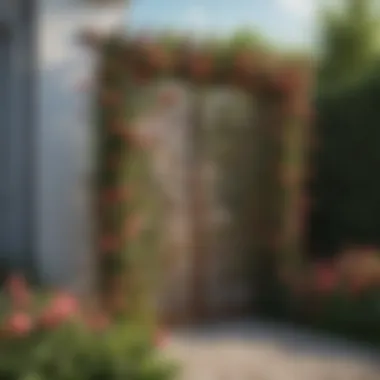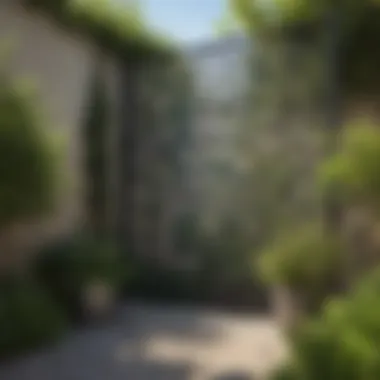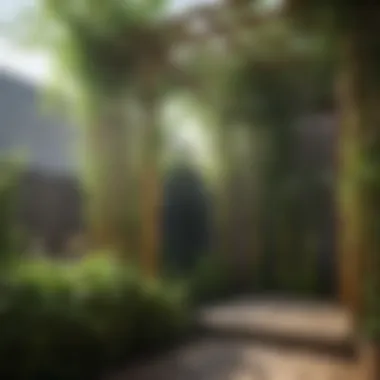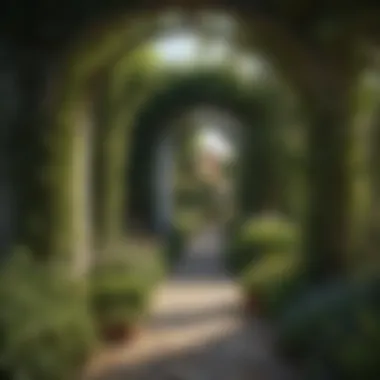Creative Garden Trellis Ideas to Enhance Your Space


Intro
Garden trellises serve as more than just functional support for climbing plants; they also play a significant role in enhancing garden aesthetics. In today's gardening landscape, a trellis can be a focal point, adding character to any space. With numerous materials and designs available, every gardener can find the perfect style that aligns with their individual's taste. This article focuses on ten creative garden trellis ideas. Each idea is designed to complement a myriad of gardening styles, making them suitable for both novice and experienced gardeners.
By carefully selecting plants that thrive in conjunction with trellises, homeowners can maximize vertical space while ensuring a healthy garden. Additionally, understanding the various applications of trellises within diverse environments is vital for creating a harmonious garden.
Design Inspiration
Designing your garden with a trellis in mind starts with inspiration. The current trends in garden design emphasize simplicity and functionality. Homeowners now appreciate minimalist structures that increase visual appeal without overwhelming the landscape.
Furthermore, color schemes are essential in achieving a cohesive garden look. Trellises made from natural wood can complement green foliage, while painted metal structures can introduce bold hues.
Gardening Techniques
Effective garden techniques are key to ensuring a successful trellis installation. Plant selection and care are crucial. Choosing suitable climbing plants, such as sweet peas or clematis, can add layers of color and texture. These plants often require similar care, making maintenance easier.
While trellises are commonly used in outdoor gardens, they are also adaptable for indoor settings. An indoor trellis can enhance spaces with limited natural light, providing an opportunity for homeowners to cultivate their green thumb within their living spaces.
Prolusion to Garden Trellis
Garden trellises hold a significant yet often overlooked position in gardening. These structures serve as both functional tools and aesthetic elements. Trellises help support climbing plants, maximize space, and enhance the overall visual appeal of a garden. Understanding the role of trellises is essential for any gardener who seeks to improve their outdoor space, be it a modest backyard or an expansive landscape.
Definition and Purpose
A garden trellis is typically a framework that supports climbing plants or vines. Made from various materials such as wood, metal, or vinyl, trellises facilitate vertical gardening, allowing plants to grow upward rather than outward. This design not only saves valuable ground space but also promotes better air circulation and sunlight exposure for the plants.
Trellises serve multiple purposes. They can provide structural support for vegetables like peas and tomatoes, which need assistance as they grow. Additionally, certain plants, such as clematis or climbing roses, thrive when encouraged to climb. Beyond plant support, a trellis can act as a decorative feature, transforming a simple garden into a captivating visual experience. Overall, the purpose of a trellis combines functionality with beauty, making it a versatile choice in garden design.
Historical Context
Historically, the use of trellises dates back to ancient civilizations. Initially crafted from natural materials like bamboo and wood, these structures were essential for supporting horticultural endeavors. Ancient Egyptian gardens showcased climbing plants supported by scaffolding like trellises, signifying their importance even in early agricultural societies.
In the ages that followed, especially during the Renaissance, trellises gained prominence in landscape architecture. They became integral to formal gardens, prominently displaying romantic climbing roses and elegant vines. The evolution of garden trellises reflects cultural shifts and design trends, as it adapts to various aesthetics across different periods. Today, while still rooted in functionality, trellises reflect modern garden styles and preferences, merging innovation with tradition. Understanding this historical backdrop allows gardeners to appreciate the craftsmanship and evolution of these structures, adding depth to their garden projects.
Functionality of Trellises
Trellises play a critical role in garden design, serving multiple functionalities that benefit both plants and aesthetics. Their integration can enhance the liveliness of garden spaces while optimizing the use of available area. Below, we break down three key aspects of trellis functionality: space optimization, support for climbing plants, and aesthetic enhancements. Each serves a distinct purpose, contributing to the overall effectiveness of the garden's design.
Space Optimization
In small gardens or urban settings, maximizing space is often a priority. Trellises allow gardeners to use vertical space instead of just horizontal ground. By encouraging plants to grow upward, a trellis can significantly increase the efficiency of planting layouts.
- Vertical Growth: Climbing plants utilize trellises to reach new heights, allowing for a greater diversity of flora within a limited footprint.
- Increased Yield: In vegetable gardens, vines like beans or cucumbers benefit from vertical growth, resulting in higher yields by minimizing ground take-up.
- Accessibility: Trellises can also help with accessibility. Raised trellises allow easy access to plants without the need to bend or stoop, aiding in the gardening experience for individuals with limited mobility.
This not only makes gardening easier but enhances productivity.
Support for Climbing Plants
Trellises provide essential structural support for various climbing plants. Certain plant varieties would struggle or fail without a means of elevation. Providing support is vital for several reasons:
- Healthy Plant Growth: By allowing plants to climb freely, trellises help them grow in a healthier environment, avoiding rot that often occurs when plants sit on moist ground.
- Sunlight Exposure: Climbing assistance ensures that plants receive adequate sunlight, which is crucial for photosynthesis and overall health.
- Wind Resistance: Trellised plants are better protected against harsh weather, as their height can shield them from strong winds that might otherwise break stems or uproot delicate growth.
Aesthetic Enhancements
A trellis does not merely serve functional purposes; it also enhances the garden's visual appeal. The presence of a trellis can transform a mundane garden layout into something striking. There are a few ways this enhancement manifests:
- Vertical Interest: Trellises create vertical lines which contrast against the predominantly flat landscape of a garden.
- Focal Points: They can serve as focal points, drawing the eye towards flowering vines, which add color and texture to the space.
- Architectural Appeal: Different styles of trellises can complement various garden themes, from rustic wooden designs to sleek modern metal frameworks.
"A well-placed trellis can elevate the entire atmosphere of your garden, providing both beauty and function."


In summary, trellises are not just additions; they are integral components for any garden. They maximize space efficiently, offer reliable support to climbing plants, and significantly enhance the overall aesthetic appeal of garden areas. As gardeners explore options, understanding these functionalities encourages more informed decisions toward creating stunning green spaces.
Material Options for Trellises
When selecting a trellis for your garden, the material is a crucial consideration. Each material has distinct characteristics that can influence durability, aesthetics, and maintenance. Choosing wisely can enhance the functionality and beauty of your garden while providing the necessary support for your plants. Here, we will explore three popular options—wood, metal, and vinyl—and their benefits and drawbacks, allowing homeowners and gardening enthusiasts to make informed decisions.
Wooden Trellises
Wooden trellises are perhaps the most traditional choice. They offer a natural look that integrates well with various garden styles. Common woods used include cedar, redwood, and pine, each providing different levels of durability and resistance to rot.
Benefits of wooden trellises include:
- Aesthetic Appeal: The organic appearance of wood can enhance the overall beauty of your garden.
- Customizability: Wood can be easily cut, shaped, and painted, allowing for personalized designs.
- Environmental Consideration: If sourced sustainably, wooden trellises can be an eco-friendly option.
However, wooden trellises do require regular maintenance. They may need treatment to prevent rot or insect damage. Additionally, weather conditions can affect their lifespan, so careful consideration is needed regarding placement and type of wood used.
Metal Trellises
Metal trellises are growing in popularity for their modern appeal and exceptional durability. Common materials include wrought iron, aluminum, and galvanized steel.
Advantages of metal trellises are:
- Longevity: Metal can withstand various weather conditions without degrading quickly.
- Stability: They often provide robust support for heavier climbing plants.
- Minimal Maintenance: Unlike wood, metal does not require frequent treatment, although rust prevention is advisable in moist climates.
On the downside, metal trellises can be more expensive and may lack the charm of wood. Some homeowners find them too harsh for garden aesthetics, but this can often be mitigated with the right design choices.
Vinyl Trellises
Vinyl trellises represent a modern alternative, combining low maintenance with a pleasing appearance. Made from high-quality plastic materials, they come in various styles and colors.
Key benefits of vinyl trellises include:
- Low Maintenance Needs: They do not require painting or staining and can be easily cleaned with soap and water.
- UV Resistance: Vinyl is resistant to fading and degradation from sunlight, ensuring it looks good over time.
- Variety of Designs: Vinyl trellises are available in numerous styles, allowing for flexibility in design.
However, vinyl can be less sturdy than wood or metal and may not support heavy climbers as effectively. It's essential to consider the types of plants you intend to grow when opting for this material.
Choosing the right trellis material is about balancing aesthetics, functionality, and personal preference. Each option provides distinct advantages, and the right fit will depend on your garden's needs and style.
Design Ideas for Trellises
Designing a garden trellis goes beyond mere function. It plays a crucial role in both the appearance and practicality of a garden space. A well-thought-out design can enhance the beauty of a garden, provide necessary support for climbing plants, and serve multiple purposes. When considering trellis design, you should think about the overall style of your garden, the materials you wish to use, and how the trellis will interact with plants. The right design can transform a simple garden into an enchanting environment, capturing the eye and inviting exploration.
Classic Vertical Trellis
A classic vertical trellis is a fundamental design in many gardens. This type of trellis consists of a simple framework that supports climbing plants, allowing them to grow upwards. The vertical aspect maximizes limited space while providing a striking visual element. When choosing this design, consider the height and width to fit the available space. You can opt for materials like wood or metal, depending on the garden's style and the plants involved.
Some popular climbing plants for this trellis style include:
- Peas – Ideal for vegetable gardens.
- Clematis – Adds vibrant flowers.
- Morning Glory – Offers bright colors and quick growth.
A classic vertical trellis can also serve as a backdrop for flower beds or seating areas, enhancing the garden's overall structure.
Arched Trellis Systems
Arched trellis systems introduce a more dynamic figure into your garden. This design creates an inviting pathway that not only supports climbing plants but adds a sense of elegance. The curve of the arch can frame a pathway, leading to hidden areas or special features within the garden. Materials such as wrought iron or wood are often preferred for their durability and aesthetic appeal.
When choosing plants for an arched trellis, consider:
- Roses – Their cascading blooms add romance.
- Wisteria – Offers spectacular hanging flowers.
- Passionflower – Showcases unique blooms and fruit.


The arch also provides opportunities for unique lighting arrangements, creating ambiance as the sun sets or in evening gatherings.
Lattice Trellis Layouts
Lattice trellis layouts provide a visual texture and can be implemented in various styles. The grid pattern not only supports plants effectively but allows for air circulation and sunlight penetration – essential for plant health. This design is versatile and can be used as a fence or partition, creating privacy while also being functional.
Consider using lattice trellises in:
- Raised beds – They can serve as a divider.
- Garden pathways – Direct attention to specific areas.
When selecting plants, choose those that will fill in the lattice effectively. Common choices include:
- Honeysuckle – Aromatic flowers and foliage.
- Scarlet Runner Beans – Combines function and beauty.
By integrating a lattice trellis, you create a sophisticated element that reflects both practicality and artistry.
Panel Trellis Designs
Panel trellis designs offer a modern take on traditional trellises. These structures are typically made from flat, solid materials, providing a strong visual impact. Panels can be used to define spaces or as decorative backdrops, supporting a variety of climbing plants. They can be painted or stained to match the garden's theme, offering customization in design.
Ideal choices for panel trellis include:
- Jasmine – Fragrant flowers enhance any space.
- Climbing Hydrangea – Adds depth with its lush foliage.
- Grapevines – Functional as well as decorative.
Incorporating panel trellises can create a sleek, contemporary feel in your garden, balancing aesthetics with plant growth.
Tip: The choice of plants is crucial when implementing any trellis design. Opt for varieties that thrive in your local climate and will mesh well with the trellis structure.
Integrating Trellises into Garden Designs
Integrating trellises into garden designs is crucial for optimizing space and enhancing the overall aesthetic of a garden. A well-placed trellis can serve multiple purposes, making it a versatile addition for various gardening styles. When considering the integration of trellises, one should focus on specific elements such as functionality, plant compatibility, and visual appeal.
Trellises not only beautify a garden but also enable efficient use of vertical space. This is particularly important for gardeners with limited area who wish to maximize their planting potential. For example, vertical gardens can be entirely transformed by using trellises to accommodate climbing plants, thereby creating a lush and fruitful atmosphere in a confined space. Additionally, they provide support for plants that require elevation, which can minimize ground pests and diseases associated with low-lying plants.
Moreover, an aesthetically pleasing garden can significantly increase the value of a property. Trellises help create natural focal points that can draw the eye from various angles.
Here are some benefits to consider when integrating trellises:
- Vertical Growth: Encourages plants to grow upwards rather than outwards, saving space.
- Improved Airflow: Enhances circulation among plants, reducing mildew and decay risks.
- Seasonal Interest: Different plants blooming at various times maintain visual interest year-round.
Trellis for Vegetable Gardens
Trellises can be exceptionally beneficial in vegetable gardens. Climbing vegetables such as peas, cucumbers, or beans thrive when supported by trellises. This elevates them off the ground, helping to prevent rot and pests while allowing better access for harvesting. The ability to see and reach the vegetables easily can greatly enhance the gardening experience.
The choice of material for a vegetable garden trellis should be considered carefully. One can use wooden, metal, or even PVC piping, with each material offering unique advantages in terms of durability and cost. Choosing the right plant variety adds to this optimization, as fast-growing and prolific climbers can cover the structure quickly, leading to increased yields per square foot.
Trellis in Flower Gardens
In flower gardens, the integration of trellises acts as a backdrop for blooming plants, offering not just structural support but also contributing to the overall design. Flowering vines such as morning glory or clematis can cascade beautifully from various types of trellises. When selecting a trellis for flowers, consider factors like height and style. A tall, elegant trellis can serve as a vertical statement piece amidst lower-growing plants, while a wide panel might create a soft border along a pathway or patio.
Color and design should complement the flowers being grown. A rustic wooden trellis might suit organic gardens better, while a sleek metal structure can enhance contemporary settings. This thoughtful approach lends itself to a harmonious garden environment.
Trellis as Privacy Screens
Trellises are not only functional for plants but can also serve as effective privacy screens. Using trellises strategically allows gardeners to create secluded areas within their outdoor spaces. By planting dense climbing vines such as jasmine or ivy, one can achieve a full privacy wall that beautifies the garden while effectively screening unwanted views.
In terms of installation, consider the orientation and location of the trellis. Positioning it to catch sunlight promotes healthier plant growth, while also blocking noticeable lines from neighbors. Seasonal plants can add a dynamic aspect to this setup, allowing changes in foliage and blooms throughout the year. This not only enhances privacy but also enriches the sensory experience of being in the garden.
Integrating trellises into garden designs offers a blend of beauty and practicality. This combination can transform any garden into a vibrant and functional space, maximizing both utility and aesthetics.


Plant Selection for Trellises
Choosing the right plants for your trellis is a fundamental step in creating a visually appealing and functional garden. The selection plays a crucial role in how the trellis integrates with the environment, the level of care required, and the overall aesthetic achieved. Different plants provide various benefits. They can create privacy, enhance beauty, or even yield edible produce.
When selecting plants, consider the specific growing conditions, such as sunlight, soil type, and climate. Additionally, the size and strength of the trellis must be compatible with the chosen plants. This ensures that the growth habits of the climbers match the support provided by the trellis.
Climbing Vegetables
Climbing vegetables can maximize space and yield in your garden. These plants utilize vertical space efficiently, which is essential in smaller areas. Some popular choices include:
- Pole Beans: Known for their vigorous growth, pole beans produce high yields and mature quickly.
- Cucumbers: This plant can easily wind its way around a trellis, providing a bountiful harvest while keeping fruit off the ground, reducing disease.
- Tomatoes (Indeterminate varieties): These can benefit from trellising by improving airflow and easing the harvesting process.
When selecting climbing vegetables, ensure they receive sufficient sunlight and have adequate support for their weight, especially when fruit-bearing.
Flowering Vines
Flowering vines contribute beauty and color to garden spaces. They create lush vertical displays, drawing attention and creating stunning backdrops. Some suitable options include:
- Clematis: This perennial vine comes in various colors and bloom sizes. Its flowering times can help ensure extended displays throughout the growing season.
- Wisteria: Famed for its cascading clusters of flowers, wisteria can create dramatic effects when allowed to climb.
- Sweet Pea: Known for its sweet fragrance and colorful blooms, this annual vine can enhance the sensory experience of your garden.
When choosing flowering vines, consider the bloom period and ensure that the trellis structure is strong enough to support the plant's growth.
Evergreen Climbers
Evergreen climbers provide a year-round option for maintaining garden aesthetics. They bring life during winter months, offering structure and foliage. Good selections include:
- English Ivy: This hardy plant can thrive in various conditions, quickly covering a trellis or wall. Its adaptability makes it a favored choice.
- Climbing Hydrangeas: Known for their beautiful clusters of flowers in summer, they also retain leaves in winter. This gives your garden a multi-season appeal.
- Star Jasmine: This evergreen plant produces beautiful flowers and offers a delightful fragrance. It can create a dense, lush backdrop while remaining evergreen.
Selecting the right evergreen climbers can be essential for creating a garden that looks alive and vibrant throughout the year.
"Choosing the right plants is vital. A harmonious blend enhances both aesthetics and functionality in any garden."
In summary, plant selection for trellises is a thoughtful process. By considering different categories like climbing vegetables, flowering vines, and evergreens, you can create a diverse and thriving garden landscape that meets your design goals.
Maintaining Your Trellis
Maintaining your trellis is crucial for both aesthetic and functional reasons. A well-maintained trellis not only supports the plants effectively but also enhances the overall appearance of your garden. Regular maintenance ensures longevity and optimal performance of the trellis structure. Neglecting maintenance can lead to decreased support for climbing plants, making them vulnerable to various issues such as pests and diseases. Therefore, incorporating a structured maintenance regimen is essential to preserve the beauty and functionality of your trellis.
Regular Inspections
Regular inspections of your trellis are essential. Inspecting the trellis frequently allows you to identify any signs of damage or decay early. Wooden trellises, for instance, may suffer from rot if they come in contact with soil or excessive moisture. Metal trellises can rust, especially in moist climates. By checking for these issues, you can take action before they result in serious problems.
During inspections, look out for loose connections, broken parts, or any growth of unwanted plants that might compromise the structure. It is also wise to examine the growth of the climbing plants. Ensure they are not damaging the trellis by growing too heavily or in a disorganized manner. Taking these steps will help you maintain a functional and visually appealing installation.
Cleaning and Upkeep
Cleaning your trellis is another critical maintenance activity. Dirt, algae, and plant residue can accumulate on the structure, which not only affects its appearance but can also lead to deterioration. To clean your trellis, use a soft brush or cloth with warm water and mild soap. This method will effectively remove debris without causing damage.
In addition to cleaning, you should perform upkeep tasks, such as sealing wooden trellises with weather-resistant treatments. This helps prevent rot and extends the life of the material. For metal structures, applying rust-resistant paint or sealant can help in maintaining appearance and durability. If your trellis requires repairs, address them promptly. Tightening screws or replacing missing pieces when needed is key to preserving the functionality of the structure.
Key Tip: Establish a seasonal maintenance schedule to keep your trellis in prime condition. Regular check-ups and cleaning will save you time and effort in the long run.
Culmination
In this article, we have explored a variety of garden trellis ideas that serve multiple purposes. The conclusion points to the significance of incorporating trellises into home gardens, emphasizing both their functional and aesthetic roles. Trellises not only support climbing plants but also contribute to the overall landscape design.
Summary of Key Points
The key points discussed include:
- Definition and Purpose: Trellises are structures designed to support plants, improving space utilization in small gardens.
- Material Options: Various materials like wood, metal, and vinyl offer different looks and durability.
- Design Ideas: From classic vertical versions to arched systems, these designs can complement any garden style.
- Integration: Understanding how to integrate trellises effectively in areas like vegetable gardens enhances both aesthetics and practicality.
- Plant Selection: Selecting the right plants for trellises can create visual interest and enhance space efficiency.
- Maintaining Trellises: Regular inspections and cleaning are crucial for the longevity of these structures.
Final Considerations
When considering a trellis, reflect on your garden's specific requirements and personal style. A well-chosen trellis can serve as an architectural feature, transforming an ordinary space into something remarkable. The options are vast, catering to everyone from hobby gardeners to those seeking a sophisticated landscape. Every choice has implications, from the materials to the plants you select.
"A trellis is not just a tool for plants; it is a statement in garden design."
Taking the time to plan and execute your trellis design can yield significant satisfaction. As you navigate through different ideas, remember to focus on how these elements can harmonize with the surrounding environment. Ultimately, the right trellis can elevate your gardening experience, fostering growth both in plants and personal creativity.



